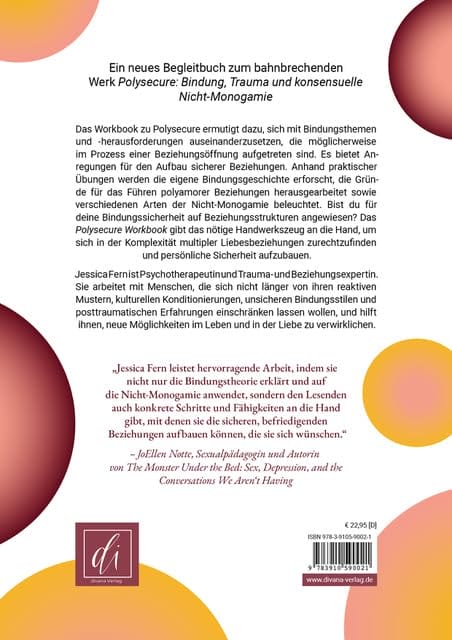Polyamory - a term that now arouses interest among many people and often provokes heated discussions. The concept of pursuing multiple consensual romantic relationships at the same time shakes the foundations of traditional relationship patterns.
Jessica Fern , a renowned clinical psychologist and relationship expert, sheds light on the complex world of polyamorous relationships with her new book, Polysecure . Fern not only presents theoretical models, but also offers practical advice for those seeking a polyamorous lifestyle .

German version available on Amazon
Let us use the book publication as an opportunity to delve deeper into the matter and discover how trust and a feeling of security in polyamorous relationships can be built and maintained.
The basics of polyamory
The links marked with a symbol are affiliate links. We generally only recommend products that we use (or would use) ourselves. If you visit affiliate links in our content, we may receive a commission for your purchase (at no additional cost to you). This is how we finance the free editorial content for you ( more details here )
Polyamory ( polyamory ), derived from the Greek “poly” (many) and the Latin “amor” (love), is the practice of having multiple romantic relationships at the same time - with the knowledge and consent of all partners involved. Unlike affairs , which are characterized by secrecy and breach of trust, polyamory is based on communication , transparency and consent .
Historical context
Interestingly, polyamory is not a new invention. Different forms of non-monogamous relationships have existed in many cultures around the world for centuries. The Aztecs, some African tribes and various indigenous peoples of North America lived polyamorous lives.
Particularly noteworthy is ancient Greek society , in which both men and women often pursued romantic and sexual relationships outside of marriage.
a resurgence in the 1960s and 1970s with the sexual revolution
Interesting statistics on polyamory
To get a better understanding of the prevalence and acceptance of polyamory, let's take a look at some interesting statistics:
- Prevalence 2023 study by YouGov commissioned by dating site Ashley Madison
- Acceptance YouGov 's survey, 25% of Millennials and 12% of the general U.S. population said they see open or polyamorous relationships as a viable form of relationship.
- Demographics : Research from the Kinsey Institute showed that polyamory is particularly common among LGBTQ+ people, with about 20% of lesbian, gay and bisexual Americans having had at least one polyamorous relationship.
- Duration : According to a study published in the Journal of Sex Research , polyamorous relationships are often longer-lasting than generally assumed. More than half of the polyamorous couples surveyed reported that they had been together for more than five years.
- Satisfaction : A survey by the University of Innsbruck found that 76% of people surveyed in polyamorous relationships are satisfied or very satisfied with their love life.
Important aspects of polyamory
Jessica Fern argues that successful polyamorous relationships rest on three key pillars: communication, trust and boundaries. Let's consider these points in more detail.
communication
When it comes to polyamory, open and honest communication is key. All partners must clearly articulate their wishes, needs and boundaries. It helps to organize regular “check-ins” where everyone involved can talk about their feelings and expectations.
An interesting fact about this: In some polyamorous households there are special “relationship calendars” that ensure that everyone has time for communication and joint activities.
Trust

Photo by Helena Lopes @wildlittlethingsphoto, via Unsplash
Trust is the foundation of any successful relationship, and this is even more true in polyamory. Breaking trust can have devastating consequences, so it's important to cultivate a culture of honesty and transparency.
Jessica Fern suggests incorporating regular trust exercises and mindfulness techniques to build a solid foundation.
demarcation
Boundaries are crucial in the context of polyamory because it is about recognizing and respecting your own boundaries. This means clearly defining and communicating both emotional and physical boundaries.
Fern emphasizes that each partner must take responsibility for their own needs and boundaries to ensure a healthy balance.
Challenges in polyamorous relationships
polyamorous relationships offer tremendous potential for fulfilling and diverse love lives, they also come with their own unique challenges.
Here are some of the most common hurdles that can arise in polyamorous lifestyles:
Jealousy and insecurity
Jealousy is one of the biggest challenges in polyamorous relationships. Contrary to popular belief, polyamorous people are not immune to jealousy. However, you must learn to deal with it constructively.
This requires deep self-reflection and the ability to communicate openly about feelings. It can be helpful to view jealousy as a signal of unmet needs and work to address them.
Interesting fact: Studies have shown that jealousy indicates insecurity and fear of losing the bond rather than a lack of trust in your partner.
Time management
Maintaining multiple relationships can be time-consuming and organizationally demanding. It requires precise time management to ensure each partner receives the attention and care they need.
Many polyamorous couples use detailed calendars and plan their time carefully to avoid misunderstandings and neglect.
Organization tip: Some people in polyamorous relationships create weekly schedules that specify when and how time will be spent with each partner - including shared projects or leisure activities.
Social stigmatization
the acceptance of polyamory in society is still limited. Many people face the problem of social stigma, especially in conservative or religious communities . This can lead polyamorous people to hide their relationship or feel misunderstood.
Tip: Joining communities and networks that support polyamorous lifestyles (even online) can help build a supportive environment and counteract stigma.
Legal aspects
Polyamorous relationships are not legally recognized, which can lead to a variety of problems, especially with regard to inheritance law, custody issues or health insurance. It requires creative and often costly legal arrangements to ensure that all partners are legally protected.
Legal tip: Legal advice from a lawyer who specializes in family law can help find tailor-made solutions for polyamorous relationship constellations.
Emotional work
Polyamory requires a high level of emotional labor. This means that everyone involved needs to work on maintaining emotional health and communication. Emotional exhaustion can be a serious problem, especially when maintaining multiple relationships at the same time.
Self-care tip: Regular time out and self-care practices, such as meditation or hobbies, help maintain inner balance and prevent emotional exhaustion.
Disagreement about rules and boundaries
Every polyamorous relationship requires individually negotiated rules and boundaries. These can change over time, which can lead to conflicts. It is crucial that everyone involved regularly checks their rules and adapts them if necessary.
Communication Tips: Open and regular communication is essential. A monthly “relationship talk” can help review and adjust expectations and rules.
Polysecure: Security in polyamorous relationships
At the heart of Jessica Fern's book is the concept of the "polysecure" relationship . This model integrates elements from attachment theory and offers practical approaches to promote security and trust in polyamorous relationships.
Attachment theory
Attachment theory, first developed by John Bowlby and Mary Ainsworth, examines how our early relationship experiences influence our later attachment patterns. Jessica Fern adapts this theory and applies it to polyamorous relationships. She emphasizes that secure attachments in adulthood must be strengthened through emotional support, reliability and commitment.
Polysecure strategies
Fern offers several strategies for promoting secure attachments in polyamorous relationships:
- Emotional availability : Make time for emotional connection and be there for your partners when they need support.
- Reliability : Keep agreements and show reliability in your actions.
- Self-care : Pay attention to your own needs and resources to avoid overwhelm and burnout.
Practical tips and tricks
Now that we understand the theoretical basics, let's turn to practical tips that can help you live polyamory successfully.
Everyday organization
Polyamorous relationships can be organizationally challenging. Plan shared and individual times and use modern tools such as calendar apps to keep track of all appointments and activities.
Conflict management
Conflicts are inevitable in every relationship. It is important to resolve conflicts constructively and take into account the needs of everyone involved. Jessica Fern recommends methods such as non-violent communication to clarify misunderstandings and find solutions.
Self-reflection
Regular self-reflection helps to better understand your own wishes and limitations. Keep a journal or set aside regular time for meditation and mindfulness exercises.

the German version, available on Amazon
Fun facts and exciting facts
- The science behind love : Did you know that studies show that the neurotransmitter oxytocin — often the “love hormone” — plays a role in both monogamous and polyamorous relationships? It is released when we experience closeness and trust, regardless of the form of relationship.
- The oldest polyamorous couple : A polyamorous trio from the USA, consisting of a man and two women, has already celebrated its 50th anniversary! They attribute their longevity to open communication and mutual respect.
- Polyamory in the animal kingdom : There are also non-monogamous patterns in the animal world. For example, bonobos are known for their diverse and complex social bonds, which often extend beyond mere reproduction.
Frequently asked questions about polyamory
Is polyamory the same as polygamy?
No, polyamory and polygamy are different concepts. Polyamory refers to multiple romantic relationships with the consent of all involved, while polygamy (multiple spouses) is often culturally or religiously anchored and is not necessarily consensual.
How do I deal with jealousy?
Jealousy is a normal feeling, but it needs to be addressed constructively. Communicate openly with your partners about your feelings and work on self-reflection and trust exercises.
Is polyamory suitable for everyone?
Polyamory is not for everyone. It requires intense communication skills, emotional maturity and a willingness to work on yourself.
Can I have a polyamorous relationship alongside a monogamous relationship?
Yes, there are models in which one partner is polyamorous while the other remains monogamous. It is important that everyone involved agrees and clear joint agreements are made.
What do psychologists think about polyamory?
Heike Melzer , a psychotherapist from Stuttgart, describes polyamory in the WELT as a “balancing act that requires a lot of energy and great courage . Because you are entering uncertain, unknown territory, far removed from the romantic, monogamous form of relationship.
Shaping such a partnership requires a lot of willingness to engage in dialogue.
Is polyamory illegal in Germany?
Although polyamorous partnerships are permitted in Germany, plural marriage, also known as polygamy, is prohibited and can be punished with a prison sentence of up to three years or a fine.
Polyamory and children: is it possible?
in the Badische Nachrichten as parents of several children who were informed about the polyamorous life of their mother and father respectively.
“I wanted my children to know who their daddy was,”
explains Peter. He wants to avoid them finding out from third parties that he is polyamorous.
For me, polyamory offers a solution to the dilemma that there can only be one partner. In contrast to classic monogamy, the family can stay together,”
Peter adds.
The topic of children also plays a central role in the relationships of another Karlsruhe resident (Mado). A woman with whom her husband is in a relationship is currently expecting a child. This was intentional from the start, explains Mado. Children should also be added to their site:
It has been clear since we became a couple that my husband and I want to have children together.”
, she says. The plan is for a family in which all adults are long-term caregivers for the children. Their goal is to provide them with “a safe haven” and a stable environment.
Through their integrative view of relationships and family, they create a space in which love and support go hand in hand. Polyamory allows them not only to have romantic relationships, but also to form an extended community that focuses on the well-being of the next generation.
Final words
Polyamory offers an alternative way to experience love and relationships that is deeply rooted in communication, trust and boundaries.
Jessica Fern's book "Polysecure" provides valuable insights and practical help to make this lifestyle successful. By understanding attachment theory and applying specific strategies, polyamorous relationships can gain security and stability.
Whether you are curious about polyamory or are already in a polyamorous relationship, Polysecure will undoubtedly provide you with valuable support and inspiration.
Sources:
- Jessica Fern: Polysecure: Attachment, Trauma and Consensual Non-Monogamy (2023), ISBN-13: 978-3910590021
- Jessica Fern: The Polysecure Workbook: Heal Your Attachments and Create Security in Loving Relationships (2024), ISBN-13: 978-3910590076
- Ashley Madison : “Gen Z Report 2023” , available as PM; Polling firm YouGov conducted a survey of 17,096 adults in ten different countries on behalf of Ashley Madison, with 3,393 respondents aged between 18 and 29. In Germany, the survey included 2,023 or 276 participants. The survey took place online between October and November 2023.
- Haslam, K.R. (2012) . Polyamory Bibliography . The Kinsey Institute for Research in Sex, Gender, and Reproduction (2012): https://kinseyinstitute.org/pdf/HaslamFindingAid.pdf
- Julica Möck: Reasons for polyamory - qualitative interviews with polyamorous people (2019), master's thesis at the Leopold Franzens University Innsbruck, https://diglib.uibk.ac.at/download/pdf/3768985.pdf
- Journal of Sex Research 52, 2014

